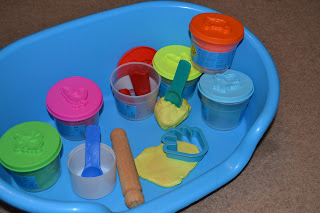Young children love colourful objects, they love to sort colours and are so proud when they can identify and name colours. Here are just a few of my colour inspired activities.
I created a colour track using patterned fabrics and included a variety
of small objects to sort on the track. The track rolls up to fit into a
plastic jar with the sorting items for easy portable storage.
Here is my Granddaughter sorting through a colour themed basket of objects.
Children love treasure baskets and these can be themed to promote learning about
specific things such as colour.
Have you come across this book?
Nick Sharratt and Sally Symes' book Something Beginning with Blue.
It's great for introducing an Eye-Spy game looking for colours
The last page has all the found objects hidden in the picture.
I make treasure bottles as a hide and seek activity with a list of objects to spot.
Here is a home made Christmas treasure bottle
Here is a commercially bought 'Find It' game
Creating a cardboard rainbow and 7 pots of sorting toys I made an
independent activity.... sort the toys onto the rainbow and back into
the colour coded boxes
The boxes contain a variety of interesting little toys and household items like buttons...
all of which keep children interested.
I can't help recreating ideas in fabric.
Here I have made a quilted rainbow, the colours being created using fabric
crayons and decorated with buttons and other embellishments.
The rainbow can be used with the sorting boxes.
Both rainbows follow the song colours Red and Yellow........
Rhyming Colours (Early reading skills)
If your child is in F1 or F2 (Nursery/Reception) have a go at this rhyming-colours game to help them develop their rhyming skills ready for reading (awareness of onset and rime) Using the rainbow or anything showing different colours...even their t-shirt, call out a word that rhymes with a colour e.g. red - bed, bread, fed, ted blue - queue, glue, shoe green - queen, scene, been
Playing with words and sounds helps your child to tune into listening for patterns and later on they will use that knowledge to decode unfamiliar words.
Colours and Mood
Have you heard about how different colours and using information from a number of sources I have come up with a brief break down of colours and how they effect the mood which could be helpful when choosing colours for your child's bedroom.
Red - enriching and warm Pink - nurturing, gentle, relaxing and restful Orange - warming, relaxing, friendly Yellow - brightening, enlivening, warming, mentally stimulating Green - cool, cold, quiet, tranquil, natural Turquoise - cool, uplifting, clears the head, aids communication Blue - cold, sterile, relaxing and peaceful if balanced with warm colours Purple - warm, powerful White - cool but frightening, cold and clinical Black - cold, frightening, tiring Brown - warm, nurturing, earthy, safe Grey - un-distracting but bland, uninspiring on its own Gold - rich, inspiring Silver - cool, feminine
These are very general statements but there are so many different shades and tones of colour so trust your instincts when choosing.
In Suzy Chazzari,s book on Colour she suggests soft, light, pastel shades for a baby/toddlers bedroom and for older children to stick with soft colours but to introduce brighter colours through curtains and bedcovers to "stimulate a child's enquiring mind". As your child gets older they may express their own preferences and she recommends parents respect this but where possible ensure they have a cosy corner decorated in muted colours such as yellow and cream so they have a down time area where they can relax and chill-out...I love this idea! Have you any ideas to share to create a chill-out area for children?
Colour Sorting Balloons
I had a spare day and fancied doing some sewing and following the colour sorting theme and the song I can sing a rainbow I made some padded fabric balloons with matching ribbon, choosing the colours from the song and a mixture of textures I also made some matching bean bags and covered some wooden shapes with the same fabric (the shapes came from a charity shop find...a game with wooden counters) The set can be used with toddlers for sorting activities. The collection boxes containing lots of little coloured items as introduced above can be used with the balloons instead of the rainbow.










































